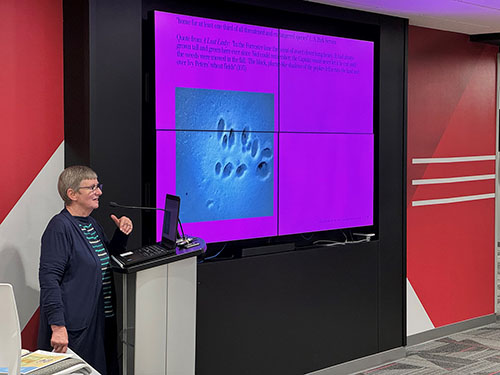She arrived with her family as a child, shortly after Nebraska had become a state. She saw the openness of the prairie and undisturbed grasses and flowers that grew wild.
In her 1923 novel, “A Lost Lady,” Cather presented a theme that instead of trying to dominate the environment, humans should work with it. That includes the importance of wetlands, said Patti Burris, Northeast adjunct instructor of foundational English and workplace communication.
Burris was the featured speaker during the latest Hawk Talk on Feb. 8. She noted how Cather recognized the importance of wetlands and nature in “A Lost Lady,” such as one of the main characters, Captain Forester, being fond of a marsh on his land.
Burris discussed how Cather used plants as a motif or idea that goes with the characters.
“You get the story of Captain Forester and his wife, Marian Forester, but you also get the story of the plants, the animals, and the land, and in this case, the wetlands during that period of time. Mrs. Forester is often compared to white lilacs because she had such pale cheeks,” Burris said.
It was not a coincidence that their last name is Forester.
“Willa Cather could have used any name, but she chose Forester because they are in favor of nature and streams,” Burris said. “They appreciate the natural beauty.”
Also not coincidentally, a despicable character is named Ivy Peters. He was nicknamed “Poison Ivy” Peters because he poisoned dogs in his neighborhood and mutilated a woodpecker by the marsh.
Cather’s work could fall into a category of eco-literature, which deals with the importance of the environment. Not everyone recognized the importance of wetlands, even then, which support a variety of plant and animal life with food, shelter, and a place where insects and other creatures could reproduce.
Wetlands also have been called the lungs of the earth.
Burris noted that it would take about 50 years from Cather’s writing before there would be any legislative action protecting wetlands. That included a global summit in 1971 known as The Ramsar Summit, followed by the Clean Water Act in 1972. That was followed by The Carter Protection for Wetlands in 1977 and the Swampbuster Act in 1985.
These regulations gave the government some say of what the farmer or owner of the wetland can do with the property, including restricting farming of them, Burris said.
The Cather novel includes how a marsh was turned into a wheat field, despite there being plenty of land to the south available for growing wheat. The result in the story is that the wheat field floods.
Burris also referenced another prominent Nebraskan, Paul Johnsgard. Johnsgard, who died in a 2021, was a scientist, noted scholar and author, among many talents.
Burris said Johnsgard studied birds and ecology, especially in Nebraska.
“He said of all the wonders of the earth, nothing is more valuable than water. That is one thing we can’t live without,” Burris said.
Johnsgard, who was a professor at the University of Nebraska-Lincoln, mentioned some of the same plants in his books that Cather mentioned. Burris purchased some of these plants last year from a local greenhouse that are “cousins” to the plants mentioned by these two authors. They are easy to grow in Nebraska.
The plants that were in the wetlands are more difficult to grow because they require the wetlands to grow, Burris said. Burris showed slides of the wetland plants and others during her presentation.
She said there is hope for the future as there seems to be more concern now for wetlands and the environment.
“All of us can do something,” she said. “Lawns are something we like to look at and take pride in, but they’re not fantastic for the environment. You can take a small patch of your land (to start) and plant a pollinator garden.”
Plants like dill will attract insects and Monarch butterflies.
“I did mine in a place where we couldn’t get grass to grow,” Burris said.
Other things that give Burris hope include the Willa Cather Prairie, which consists of about 640 acres that are preserved as pasture, and The Nature Conservancy.
“Willa Cather knew 100 years ago what we know now – that to lose a wetland is to lose something very valuable, indeed,” Burris said.
A Lost Wetland cutline
Patti Burris, Northeast adjunct instructor of foundational English and workplace communication, discusses the importance of wetlands were noted by Willa Cather at least 100 years ago in “A Lost Lady” during the latest Hawk Talk on Feb. 8. (Northeast Community College)
###

